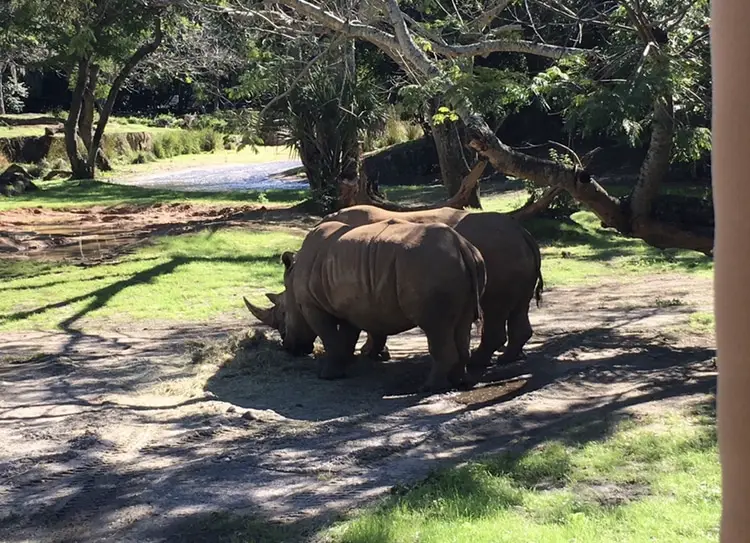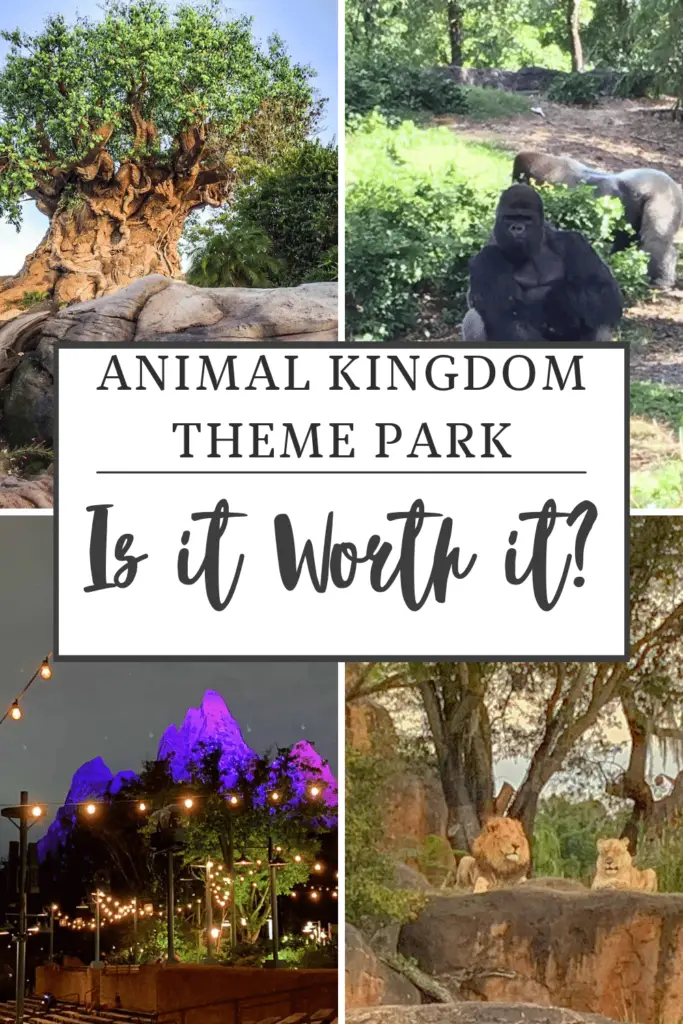On Disney World’s Kilimanjaro Safari in Animal Kingdom park, riders board open-sided safari vehicles and take a journey through Harambe Wildlife Preserve. And while we expect to see giraffes, hippos, elephants and maybe a lion or two, there is a whole world of Disney World history and some of the most fascinating Disney World secrets hiding on the savanna at Kilimanjaro Safari in Animal Kingdom.
1. Historic Narratives of Kilimanjaro Safari: Poachers and Baby Red
When Kilimanjaro Safari in Animal Kingdom opened, it followed a story line involving a poached elephant mother and her orphaned elephant calf. Guests would board the ride vehicles under the premise of a “weeks long safari” only to have the journey interrupted by radio chatter of a poached elephant and missing calf.
The safari guide would then take guests on a bumpy, fast paced chase through the savanna and over a rickety bridge looking for the poachers. The chase would end when the warden came over the radio and informed riders that the poachers had been chased into a trap thanks to their heroic efforts. You would them come upon Baby Red the elephant calf safely rescued and standing in a truck.

This ride iteration was meant to teach the dangers of poaching in Africa and saw some changes over the years until its end in 2012. One little known Disney World Secret about Kilimanjaro safari in Animal Kingdom is that prior to the park’s opening, the storyline for the ride included a fake and gruesome elephant corpse that was made to look like it had been killed by poachers. The corpse even included missing tusks. This scene did not test well and was removed before the park opened.
Over the years, the poaching scene was reduced to a shorter encounter with the warden who made a simple, and seemingly random, announcement over the radio to be on the lookout for a wandering elephant calf. This storyline did end with finding Baby Red in the truck as well, but the chase scene with the poachers quickly became shorter and shorter. By 2012, Baby Red, the poachers, and the radio messages were scrapped in favor of allowing guests to spend more time viewing real animals.

2. How Kilimanjaro Safari Ensures Animal Visibility
During Kilimanjaro safari you will see many different animals. In fact, there are 34 species, but sometimes they do not want to be found. To combat shy animals, the animal caretakers strategically place enticements to encourage animals to come into view of the ride vehicles. For some animals, this means a well-placed salt block or snack hidden in a feeder made to look like a tree stump. For others, like the lions, it means a special air-conditioned rock to encourage long naps in plain sight.
3. Kilimanjaro Safari: The Longest Attraction in Disney World

While there are many secrets about Animal Kingdom, this one shouldn’t surprise many die-hard Disney fans. Kilimanjaro Safari in Animal Kingdom is the longest attraction in the resort that is not a movie or a show. The ride experience comes in at just over 18 minutes. Although, this can vary somewhat depending on how many stops your ride vehicles needs to make to avoid animals in your path. Occasionally, a stubborn gazelle or zebra will block the path for a few minutes or more.
4. Safety Measures on Kilimanjaro Safari: Protecting Guests and Wildlife

The Safari takes up a whopping 100 acres of land in Animal Kingdom, and it seems like the animals have free roam of this. In reality, most animal species are separated by natural looking barriers to keep guests and prey animals safe. For example, the lions are kept apart from the prey animals on the savanna by an 18-foot wide moat surrounding their enclosure.
Other enclosure elements include fencing inside landscaping, and chains and cattle guards across the roads.
Mickey World Travel, Platinum Authorized Disney Vacation Planner – Let Us Help YOU Plan Your Magical Disney Adventure

We’re here to help with your Disney World vacation planning
- Let us provide a free no obligation quote (fill out quote form here or contact ka******@mi***************.com for more information)
- Get help selecting your resort and the right ticket options
Book now and receive ongoing support with your Disney World vacation. We’ll even monitor Disney World pricing for special offers and discounts and rebook you if a better deal becomes available for your hotel and travel dates.
Learn more about working with a Disney travel planner or contact us today to start planning your magical Disney adventure.
5. Timing Your Trip to Kilimanjaro Safari in Animal Kingdom
The animals in Kilimanjaro Safari have minds of their own and tend to make their own schedules. This can make it hard to see them all during a safari, but there are certain times of day the animals are more active. Generally, right after park opening the animals are more likely to be on the move. In the morning, the weather is cooler, and the animals are finishing up their breakfasts, so you have a better chance of seeing them.
Another great time to spot the wildlife up and about is during the evening Kilimanjaro Safari in Animal Kingdom. For a couple short years, Animal Kingdom actually had a nighttime safari with artificial sunset and moon lighting. This provided some unique animal encounters we never had during the day.
For example, at night some animals on the savanna, such as zebras, giraffes, and antelope tend to group together and interact more freely. Unfortunately, Animal Kingdom closed the nighttime safaris. But, by riding the last safaris of the day, you’ll see the animals moving around more, and a bit wound up as they wait for dinner time.

Animals are also more active during the rain, so don’t skip this attraction because of weather!
6. Behind the Scenes: Animal Training at Kilimanjaro Safari
Some of you may not know that the animals do not sleep in their enclosures in Kilimanjaro Safari! Each group of animals is called in nightly to take a break from their “jobs” on the savanna. To call them in, each species is taught to come to a different sound. Some sounds include bells, whistles, drums, and more.

Some animals also call Disney’s Animal Kingdom Lodge home. These animals are rotated through the savannas of the lodge as well as backstage areas.
7. The Connection Between Jungle Cruise and Kilimanjaro Safari
Not too many people know that the Jungle Cruise and Kilimanjaro Safari are linked to each other through Walt Disney. When Walt came up with the idea for the Jungle Cruise in Disneyland, he wanted to use real animals. Unfortunately, this was very cost prohibitive at the time, so animatronics were used instead.

Walt continued to dream of an attraction that featured real animals, and when Kilimanjaro Safari in Animal Kingdom opened in 1998, his dream had finally been realized.
8. The Changing Roles of Zebras in Kilimanjaro Safari
There are still rumors flying around that zebras cannot be found at Kilimanjaro Safari in Animal Kingdom. The zebra Disney World history is a little rocky and confusing. Zebras were on the safari from opening until 2012 when they were removed to backstage areas. Staff said they were removed to make way for a new Zebra enclosure, that would take the place of the old Baby Red scene and close the ride. Shortly after, the Zebra enclosure opened.
Unfortunately, after a few months, guests began seeing addax in the zebra habitat instead. Many guests reported being told by cast members that the new zebra herd was not settling in well with each other or the new habitat. Others were told the zebras were blocking ride vehicles and fighting.

The internet seemed to be up in arms about whether or not the zebras were there. Some guests would see them on certain days, and other days the addex would be in their place.
There is still some confusion as to whether zebras exist at Disney World, but the zebras are very much apart of Kilimanjaro Safari in Animal Kingdom. Occasionally, the zebras are held backstage while the apex are in the final scene. If you do not see the zebras, come back to the safari on a different day, or time of your trip and you are sure to see them!
Zebras are also featured often on the savanna at Disney’s Animal Kingdom Lodge.

9. Unexpected Guests: Non-African Animals at Kilimanjaro Safari
A quite comical fact about Kilimanjaro Safari in Animal Kingdom is that some non-themed animals call the landscape home. While Disney would prefer to keep these animals out, it is nearly impossible to discourage native Floridian birds from settling into the savanna. While riding the safari you may notice ducks, ibis, and vultures.

In fact, one cast member said these non-themed animal guests created more reactions from her safari passengers than the African wildlife did. This cast member seemed quite miffed and offended by that, so next time you ride Kilimanjaro Safari, try not to exclaim about a duck or two sitting with the flamingos!
10. Wildlife Checklist: What to Spot on Kilimanjaro Safari
While we have already discussed Zebras calling Kilimanjaro Safari in Animal Kingdom home, there are many more species you may (or may not) see while on your safari. These include: giraffes, elephants, hippos, white and black rhinos, okapi, bongos, nyalas, kudus, common waterbucks, flamingos, impalas, mandrills, gazelle, crocodiles, antelope, wildebeests, lion, cheetahs, elands, ostriches, warthog, scimitar-horned onyx and of course, zebras. There are also many varieties of African birds.

Memorable Moments from Kilimanjaro Safari
During our 20+ years of visiting Disney World, we have been on Kilimanjaro Safari more times than we can count. We always go multiple times a trip, and enjoy it each time.
The experience changes dramatically based on time of day, the animals on the savanna, and the safari guide you get. Some safari guides are more versed in their animal facts. During various safaris at Kilimanjaro Safari, we learned that elephants are afraid of bees. In fact, farmers often use bees to keep the elephants away from crops. We also learned that an Oryx can go 9 months without water and giraffes sleep in 5 minute intervals for total sleep of as little as 30 minutes a day.
My favorite memories of the safari occurred during the night time safaris, during the short years those were offered to general park guests. During these safaris the animals are much more active. We saw hyenas running and yelling, and got to see the lions roaring on their large rock.
If you are wanting a night time safari experience, Disney now offers an exclusive nighttime safari for an added fee.
One of the most intense moments we had during the safari involved the rhinos. One of the rhinos stood directly in front of our safari vehicle, as the other walked right next to where I was sitting. Had i been more daring to break the rules, I could have touched it.
Luckily our safari driver remained calm, kept us safe, and had us on our way again quickly.
Every ride on Kilimanjaro Safari is a bit different, but all of them promise fun, adventure, animals, and surprises.




